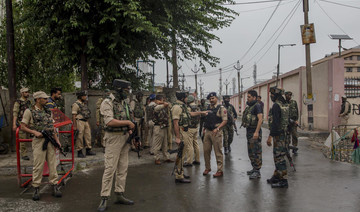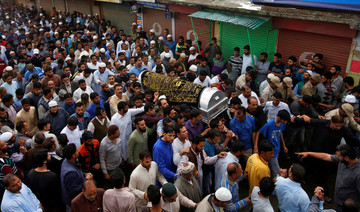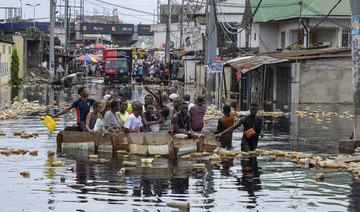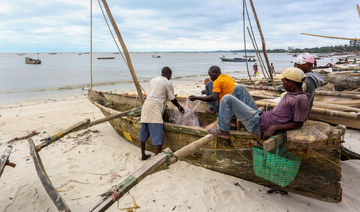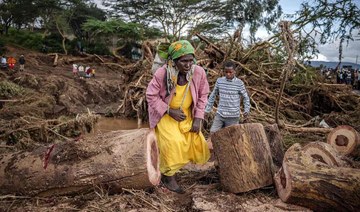NEW DELHI: India said Sunday it was resuming military operations against rebels in disputed Kashmir after a rare 30-day suspension for Ramadan expired, with a top minister blaming militant attacks.
Army operations were halted on May 16 at the start of the Muslim fasting month, despite a months-long escalation of violence in the Muslim-majority Himalayan region.
Troops would stop the pursuit of militants and door-to-door house searches but would still retaliate if attacked, officials said at the time.
“While the security forces have displayed exemplary restraint during this period, the terrorists have continued with their attacks, on civilians and SFs (security forces), resulting in deaths and injuries,” Home Minister Rajnath Singh said on Twitter.
“The security forces are being directed to take all necessary actions as earlier to prevent terrorists from launching attacks and indulging in violence,” Singh added.
“The government of India decides not to extend the suspension of operations” in Jammu and Kashmir state, Singh’s office said in a separate statement on Twitter.
“The operations against terrorists to resume,” it added.
The government’s suspension had failed to halt the mounting death toll in Indian-administered Kashmir, which is also claimed by Pakistan.
A youth died after being hit by a paramilitary vehicle during a demonstration. A number of militants and at least five soldiers or police were also killed in clashes.
One young Indian soldier from Kashmir, who was on leave for the end of Ramadan, was abducted and murdered by suspected rebels.
Prime Minister Narendra Modi held a cabinet meeting on Thursday to discuss whether to extend the initiative, amid a heated debate on the move. It was the first time in almost two decades that Indian authorities had suspended military operations against militants.
The killing of the abducted soldier and the shooting last week of a leading Kashmir editor, Shujaat Bukhari, put pressure on the government to resume operations.
The home minister said the suspension had been ordered “in the interests of the peace-loving people” of Kashmir “to provide them a conductive atmosphere to observe Ramadan.”
Violence in Kashmir has escalated since troops killed a top militant commander in 2016. Last year was the deadliest in the region for the past decade.
Kashmir has been divided between India and Pakistan since the end of British rule in 1947 and the two nations have fought two wars over the territory.
Rebel groups seek independence or a merger of the territory with Pakistan. India accuses Pakistan of arming the rebels but Islamabad says it only gives diplomatic and moral support.
India to resume military strikes on Kashmir militants
India to resume military strikes on Kashmir militants
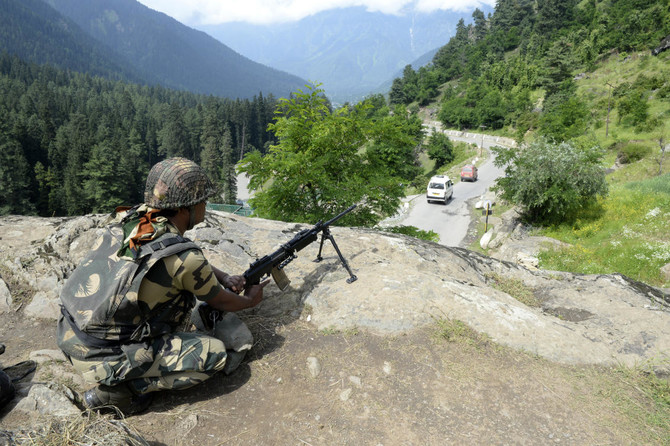
- Troops would stop the pursuit of militants and door-to-door house searches but would still retaliate if attacked
- A youth died after being hit by a paramilitary vehicle during a demonstration. A number of militants and at least five soldiers or police were also killed in clashes
Daesh claims bombing in Afghanistan that killed officers involved in an anti-poppy crop campaign
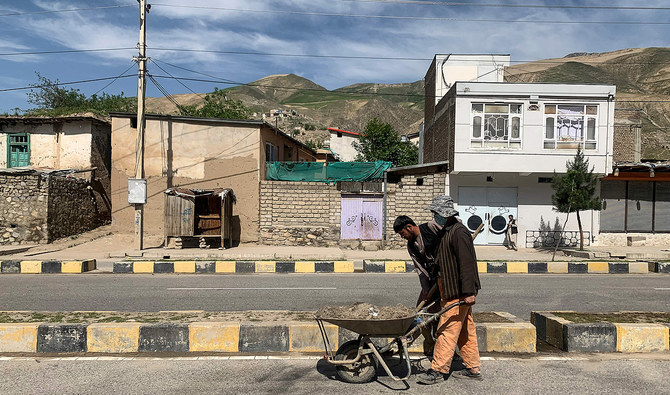
- Daesh group’s affiliate has conducted attacks on schools, hospitals, mosques and Shiite areas across Afghanistan
- The Taliban pledged to wipe out the country’s drug cultivation industry and imposed a formal ban in April 2022
ISLAMABAD: The Daesh group claimed responsibility for a bombing in Afghanistan’s northeast that killed police officers who were part of an anti-poppy crop campaign.
A motorcycle was booby-trapped and exploded, targeting a Taliban patrol in Faizabad town in Badakhshan province, killing and wounding 12 members of the patrol as well as destroying a four-wheel drive vehicle, the group said in a statement late Wednesday.
Abdul Mateen Qani, a spokesman for the Interior Ministry, said the officers were on their way to destroy poppy crops in the area.
The Daesh group’s affiliate in Afghanistan, a major Taliban rival, has conducted attacks on schools, hospitals, mosques and Shiite areas throughout the country. In March, the group said one of its suicide bombers detonated an explosive belt among Taliban gathered near a Kandahar bank to receive their salaries.
The Taliban pledged to wipe out the country’s drug cultivation industry and imposed a formal ban in April 2022, dealing a heavy blow to hundreds of thousands of farmers and day laborers who relied on proceeds from the crop to survive. Opium cultivation crashed by 95 percent after the ban, a report from the UN Office on Drugs and Crime said last November.
Protests are rare in Afghanistan under Taliban rule, but there was a backlash in Badakhshan last week in response to the poppy eradication campaign.
It prompted a high-ranking delegation led by the chief of military staff Fasihudin Fitrat to visit the region and negotiate with protesters.
Protests erupted last Friday after a man was shot and killed by the Taliban for resisting poppy eradication attempts in Darayum district. Another was killed on Saturday during a protest in Argo district.
India’s Modi skips election in Kashmir as critics dispute integration claims
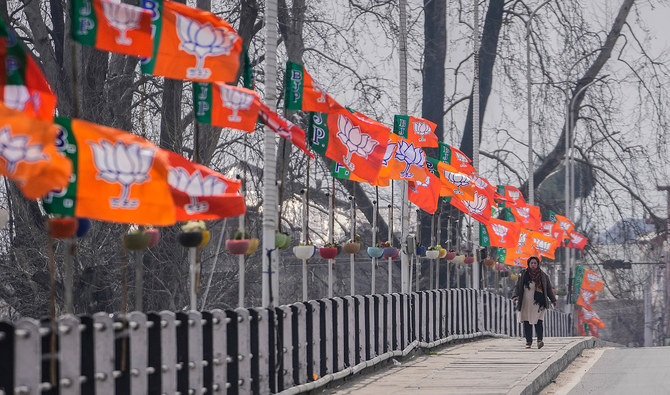
- Narendra Modi says the 2019 revocation of special constitutional status brought normalcy to Kashmir
- Critics say the BJP should have treated the election as a referendum in its favor, but it seems ‘scared’
ANANTNAG, India: Prime Minister Narendra Modi is crisscrossing India in a marathon election campaign but, for the first time since 1996, his Bharatiya Janata Party (BJP) is not contesting in Kashmir, where a 35-year uprising against Indian rule has killed tens of thousands of people.
Instead, the main contenders for the three seats in the Muslim-majority region are powerful local parties, the National Conference and the People’s Democratic Party (PDP). They will contest against each other but both say they are opposed to the Hindu nationalist BJP and will align with the Congress party-led opposition alliance.
Analysts and opposition parties say the BJP decided to skip contesting the election because the outcome is likely to contradict Modi’s narrative of a peaceful, more integrated Kashmir since he removed the region’s semi-autonomous status in 2019 and brought it under New Delhi’s control.
The BJP, along with allies, is contesting in every other part of India and is tipped to win a majority of parliament’s 543 seats on the back of its Hindu-first image.
“Why are they absent from the election?” asked Omar Abdullah, a leader of the National Conference and a former chief minister of Jammu and Kashmir state.
“Clearly there is a gap between what the BJP claims to have done and the reality on the ground,” he said, speaking in his home in Kashmir’s main city, Srinagar.
Modi says his 2019 decision brought normalcy to Kashmir after decades of bloodshed and that he will bring investments and jobs soon. The federal Home (Interior) Minister Amit Shah backs up the government’s position by claiming that youths now hold laptops in their hands instead of stones that they used to throw at security forces in the past.
As part of the move, Jammu and Kashmir state was split into two federally ruled areas — the Muslim-dominated Kashmir valley with the Hindu-dominated Jammu plains, and mountainous, Buddhist-dominated Ladakh.
The government slapped a harsh lockdown on Kashmir at the time and Abdullah and almost all other local leaders were held in custody for months.
Ravinder Raina, the chief of the Kashmir unit of the BJP, said the party’s decision to skip the election was part of a broader strategy, although he declined to give specifics.
“The BJP will not fight, but support a candidate who will work for peace, happiness, brotherhood and democracy,” in each of the three seats, he said. The BJP has not yet announced which of the many small parties in the fray it will support.
Alienation, discontent
Interviews with over a dozen residents, political leaders, security officials and analysts in Kashmir and New Delhi indicate that discontent and alienation continue to simmer in the heavily militarized Himalayan region.
Besides the three-decade insurgency, Kashmir is divided into India-controlled and Pakistan-controlled sectors and claimed in full by both nations. The nuclear-armed enemies have fought two of their three wars since independence in 1947 over Kashmir.
India claims that Islamic Pakistan has supported the insurgency in Kashmir, while Islamabad says it only provides moral support to the people there.
Abdul Hameed, a 50-year-old garment store owner in Pulwama town near Srinagar, said the federal government had kept the lid on Kashmir since 2019, masking the true situation.
“But it is like a spring. Right now they have crushed it. But who knows when will it burst open again,” he said.
Although there are fewer restrictions on people’s movements compared to five years ago, there are still tens of thousands of troops in the valley to enforce the peace.
For decades, residents and human rights groups have accused Indian security forces of atrocities against the mainly Muslim population. The government says cases of abuse are isolated acts and it prosecutes any soldier found guilty of human rights violations.
Indian military data show there are over 100 active militants in the region, who allegedly target security forces and workers from other parts of India. Militants killed an air force soldier in an attack on a military convoy on Saturday, officials said.
“The absence of an elected system over here is an indication of the fact that things are not as they are portrayed,” said Sheikh Showkat Hussain, a retired law professor, in Srinagar. “They (the BJP) should have treated (this election) as a referendum in their favor. But they seem to be scared.”
In the May 2019 general election, the BJP contested all three seats in Kashmir, losing them to Abdullah’s National Conference. This year, BJP is contesting the two seats in Jammu and one in Ladakh, all of which it had won in 2019.
Mehbooba Mufti, the chief of the PDP, is contesting from the Anantnag-Rajouri constituency, which many believed might have been the BJP’s best bet to enter Kashmir in this election.
Gerrymandering
In 2022, a federal government-appointed commission changed the borders of constituencies in Kashmir and Jammu.
To Kashmir’s Anantnag, which had around 1.6 million largely Muslim votes in 2019, it added around 1 million mostly Hindu voters from Jammu’s Poonch and Rajouri districts.
Mufti told Reuters that by clubbing them, the Modi administration was “changing the balance of the voters.” The BJP, she said, wants to “disempower and they want to divest, dispossess Muslims, especially the Kashmiris.”
National Conference’s Abdullah also claimed that the redrawing of the district was done to give BJP an “advantage.”
But they still didn’t field a candidate, which “tells you just how bad things must be for the BJP,” Abdullah said.
However, BJP’s Raina said that the redrawing has made the constituencies more representative of the region.
Floods misery reminder of climate’s role in supercharging rain
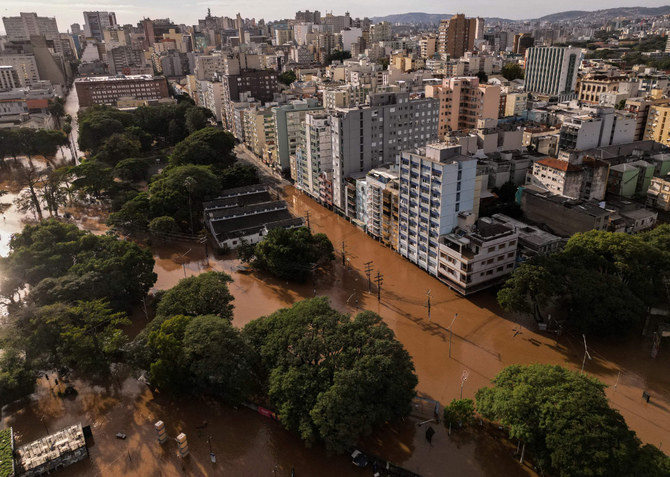
- Though not all directly attributed to global warming, they are occurring in a year of record-breaking temperatures and underscore what scientists have long warned — that climate change drives more extreme weather
PARIS: Floods have been tearing a path of destruction across the globe, hammering Kenya, submerging Dubai, and forcing hundreds of thousands of people from Russia to China, Brazil and Somalia from their homes.
Though not all directly attributed to global warming, they are occurring in a year of record-breaking temperatures and underscore what scientists have long warned — that climate change drives more extreme weather.
Climate change isn’t just about rising temperatures but the knock-on effect of all that extra heat being trapped in the atmosphere and seas.
April was the 11th consecutive month to break its own heat record, the EU climate monitor Copernicus said on Wednesday, while ocean temperatures have been off the charts for even longer.
“The recent extreme precipitation events are consistent with what is expected in an increasingly warmer climate,” Sonia Seneviratne, an expert on the UN-mandated IPCC scientific panel, told AFP.

Warmer oceans mean greater evaporation, and warmer air can hold more water vapor.
Scientists even have a calculation for this: for every one degree Celsius in temperature rise, the atmosphere can hold seven percent more moisture.
“This results in more intense rainfall events,” Davide Faranda, an expert on extreme weather at the French National Center for Scientific Research (CNRS), told AFP.
In April, Pakistan recorded double the amount of normal monthly rainfall — one province saw 437 percent more than average — while the UAE received about two years worth of rain in a single day.
This, however, doesn’t mean everywhere on Earth is getting wetter.

Richard Allan from the University of Reading said “a warmer, thirstier atmosphere is more effective at sapping moisture from one region and feeding this excess water into storms elsewhere.”
This translates into extreme rain and floods in some areas but worse heatwaves and droughts in others, the climate scientist told AFP.
Natural climate variability also influence weather and global rainfall patterns.
This includes cyclical phenomenon like El Nino, which tends to bring heat and rain extremes, and helped fuel the high temperatures seen over land and sea this past year.
While natural variability plays a role “the observed long-term global increase in heavy precipitation has been driven by human-induced climate change,” said Seneviratne.
Carlo Buontempo, a director at Copernicus, said cycles like El Nino ebb and flow but the extra heat trapped by rising greenhouse gas emissions would “keep pushing the global temperature toward new records.”
Considering the overlapping forces at play, attributing any one flood to climate change alone can be fraught, and each event must be taken on a case-by-case basis.
But scientists have developed peer-reviewed methods that allow for the quick comparison of an event today against simulations that consider a world in which global warming had not occurred.
For example, World Weather Attribution, the scientists who pioneered this approach, said the drenching of the UAE and Oman last month was “most likely” exacerbated by global warming caused by burning fossil fuels.

ClimaMeter, another rapid assessment network who use a different methodology, said major floods in China in April were “likely influenced” by global warming and El Nino.
“It can be difficult to disentangle global warming and natural variability” and some weather events are more clear-cut than others, said Flavio Pons, a climatologist who worked on the China assessment.
In the case of devastating floods in Brazil, however, ClimaMeter were able to exclude El Nino as a significant factor and name human-driven climate change as the primary culprit.
Many of the countries swamped by heavy floods at the moment — such as Burundi, Afghanistan and Somalia — rank among the poorest and least able to mobilize a response to such disasters.
But the experience in Dubai showed even wealthy states were not prepared, said Seneviratne.
“We know that a warmer climate is conducive to more severe weather extremes but we cannot predict exactly when and where these extremes will occur,” Joel Hirschi from the UK’s National Oceanography Center told AFP.
“Current levels of preparedness for weather extremes are inadequate... Preparing and investing now is cheaper than delaying action.”
Anguish as Kenya’s government demolishes houses in flood-prone areas and offers $75 in aid
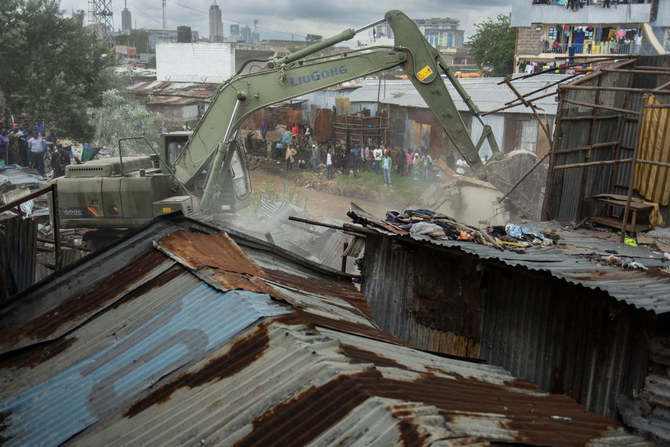
- People living near rivers, dams and other flood-prone areas told to vacate as heavy rains continue to pound
- The number of those affected by the flooding in Kenya has risen to 235,000, with most of them living in camps
NAIROBI, Kenya: Kenya’s government has begun bulldozing homes built in flood-prone areas and promising evicted families the equivalent of $75 to relocate after a deadline passed to evacuate amid deadly rains.
In the capital, Nairobi, a bulldozer ripped through iron-sheet walls as people watched in despair. Security forces with guns and batons stood guard and fired tear gas at some residents. The government last week told thousands of people living near rivers, dams and other flood-prone areas to vacate as heavy rains that have left 238 people dead in recent weeks continue to pound.
Most of those whose houses are demolished say they do not know where to go, even though the government claims they were notified about options. Human Rights Watch has accused the government of an inadequate response.
“Now what are we going to do? We love our president, and that is why we supported him. He should come to our aid,” Jekenke Jegeke told The Associated Press.
President William Ruto, who visited the vast Mathare informal settlement along the Nairobi River on Monday, said those whose houses had been demolished would be given 10,000 Kenyan shillings ($75) to help them resettle elsewhere.
Three people, including two children, have died in Mathare after being run over by bulldozers in the demolitions — one before the president’s visit and two after it — according to civil society groups.
Opposition leader Raila Odinga last week warned the government against demolishing more houses without a resettlement plan in place.
The number of those affected by the flooding in Kenya has risen to 235,000, with most of them living in camps.
Interior Minister Kithure Kindiki on Tuesday reiterated an evacuation order to 200 families living in the Kijabe area an hours’s drive from Nairobi, where about 60 people were killed and houses were swept away when water broke through a blocked railway tunnel last week.
That disaster prompted the government’s evacuation order. It is not clear how many homes across Kenya have been demolished since then.
Meanwhile, Kenya’s Cabinet has said that water levels in the country’s two major hydroelectric dams – Masinga and Kiambere – have risen to “historic levels,” with people living downstream on the Tana River told to leave.
Eastern DR Congo faces ‘catastrophe’ from floods: UN
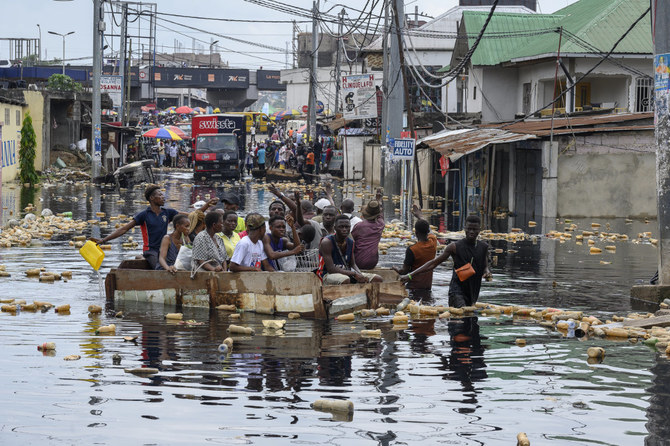
- The UN body voiced concern at the effect on health service provisions as sickness hit affected areas of the country
- Locals were reporting seeing hippos, crocodiles and snakes in flooded inhabited areas, risking fatal attacks, especially on children and livestock
KINSHASA: Eastern DR Congo faces a “humanitarian catastrophe” after being hit by severe flooding affecting about half a million people, the UN World Food Programme said Wednesday.
“Heavier rainfall than usual during the rainy season, prompted by climate change, has forced rivers and lakes to overflow, swallowing towns, villages and roads on the shores,” the WFP said in a report citing “chaos” in South Kivu and Tanganyika provinces.
Worst-affected are Haut-Lomami and Tanganyika provinces, which border the lake of the same name as well as neighboring Burundi, Tanzania and Zambia.
“All around Lake Tanganyika, and areas upstream of the Congo River basin, people have lost their homes, their fields and livelihoods,” the WFP reported, estimating 471,000 people were affected with 451,000 hectares (1.1 million acres) flooded, including 21,000 hectares of cropland.
“People in flooded areas need food, shelter, clean drinking water, health and sanitation support, as well as support to restart their livelihoods.
“However, WFP has very limited resources to respond to the flooding crisis due to current funding levels and the food assistance pipeline situation.”Democratic Republic of Congo (DRC).
“With towns and villages swallowed in the lakes and rivers, diseases are rife. Latrines have overflowed into the water that surrounds people’s homes and sanitation is poor.
“People are forced to wade through and wash their clothes and cooking implements in cholera-riddled water,” said the report, warning of “a whole host of animal-borne diseases.”
Locals were reporting seeing hippos, crocodiles and snakes in flooded inhabited areas, risking fatal attacks, especially on children and livestock.
Amid lost harvests, “people are struggling to feed their families which is leading to more people arriving in health care facilities with symptoms related to months of poor food intake. Especially children are at risk of developing malnutrition.”
Flooding has hit vast swathes of Africa in recent weeks, which have notably claimed 257 lives in Kenya, according to a latest toll Wednesday.


